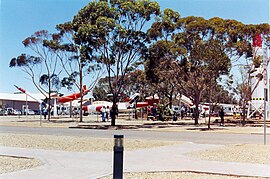
The de Havilland Propellers Blue Streak was a British Intermediate-range ballistic missile (IRBM), and later the first stage of the Europa satellite launch vehicle. Blue Streak was cancelled without entering full production.

The Australian Defence Force (ADF) is the military organisation responsible for the defence of the Commonwealth of Australia and its national interests. It has three branches: the Royal Australian Navy (RAN), Australian Army and the Royal Australian Air Force (RAAF). The ADF has a strength of just over 89,000 personnel and is supported by the Department of Defence and several other civilian agencies.
Woomera originally refers to:
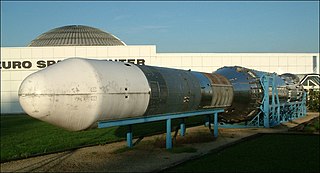
The European Launcher Development Organisation (ELDO) is a former European space research organisation. It was first developed in order to establish a satellite launch vehicle for Europe. The three-stage rocket developed was named Europa, after the mythical Greek goddess. Overall, there were 10 launches that occurred under ELDO's funding. The organisation consisted of Belgium, Britain, France, Germany, Italy, and the Netherlands. Australia was an associate member of the organisation.
The Defence Science and Technology Group (DSTG) is part of the Australian Department of Defence which provides science and technology support to safeguard Australia and its national interests. The agency's name was changed from Defence Science and Technology Organisation (DSTO) on 1 July 2015. It is Australia's second largest government-funded science organisation after the CSIRO and its research outcomes have supported operations for over 100 years.

Skylark was a family of British sounding rockets. It was operational between 1957 and 2005.
The Australian Space Research Institute (ASRI) was formed 1991 with the merger of the AUSROC Launch Vehicle Development Group at Monash University, Melbourne and the Australian Space Engineering Research Association (ASERA).

RAAF Base Scherger is a Royal Australian Air Force (RAAF) military air base located approximately 26 km (16 mi) east of Weipa on the western side of Cape York Peninsula in Queensland, Australia. One of three bare bases in a chain of bases across Australia's top end, the base is occupied by a caretaker staff and can be activated at relatively short notice. The base was constructed by troops drawn mainly from the 17th Construction Squadron, in what is believed to have been the biggest project undertaken by the Royal Australian Engineers at the time.
RAAF Base Woomera (WMA), was proclaimed by Chief of Air Force Directive in January 2015. RAAF Base Woomera and the RAAF Woomera Test Range (WTR) are the two formations which make up the RAAF Woomera Range Complex (WRC). RAAF Base Woomera consists of two sectors, 'Base Sector North' which is a restricted access area and includes Camp Rapier. the entrance to the Woomera Test Range and the RAAF Woomera Airfield. 'Base Sector South' is accessible by the public and essentially encompasses that part of RAAF Base Woomera long referred to as the Woomera Village. Woomera Village is often quoted as a 'remote town'. It is not a 'town', but rather an 'open base' of the RAAF. The 'village' has previously always functioned as an Australian Government/Defence Force garrison facility until it was fully incorporated into RAAF Base Woomera in 2015.

No. 20 Squadron is a Royal Australian Air Force (RAAF) support squadron. Coming under the control of No. 96 Wing, it is responsible for the management of the airfield at RAAF Base Woomera, South Australia. The squadron originated as a maritime patrol unit during World War II. Raised in August 1941, it operated PBY Catalina and Short Empire flying boats from bases in New Guinea, Queensland and the Northern Territory, conducting search-and-rescue, mine-laying, anti-submarine and bombing missions against Japanese targets in the Pacific theatre. Following the conclusion of hostilities, the squadron was disbanded in March 1946. It was reactivated as an airfield support squadron in April 2015.

Joint Defence Facility Nurrungar (JDFN) was an Earth station in Australia located on the edge of Island Lagoon, approximately 15 km south of Woomera, South Australia, operated jointly by the Australian Department of Defence and the United States Air Force from 1969 through to 1999. Its official area of emphasis was space-based surveillance, in particular the early detection of missile launches and nuclear detonations using U.S. Defense Support Program satellites in geostationary orbits. The name Nurrungar derives from an aboriginal term meaning "listen".
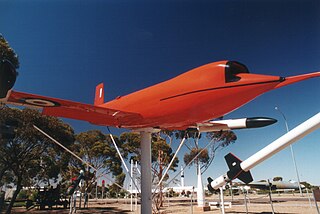
The GAF Jindivik is a radio-controlled target drone produced by the Australian Government Aircraft Factories (GAF). The name is from an Aboriginal Australian word meaning "the hunted one". Two manually-controlled prototypes, were built as the GAF Pika as a proof of concept to test the aerodynamics, engine and radio control systems, serialled A92-1/2, 'B-1/2'. The radio-controlled Jindivik was initially designated the Project B and received serials in the A93 series. Pika is an Aboriginal Australian word meaning flier.
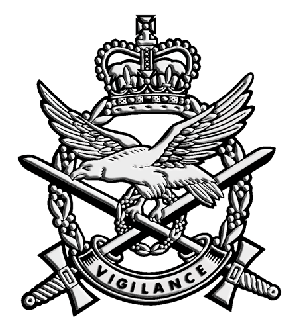
The Australian Army Aviation (AAAvn) is an administrative corps of the Australian Army. It was formed on 1 July 1968. The motto of the Australian Army Aviation corps is Vigilance.
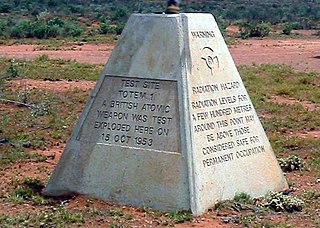
Operation Totem was a pair of British atmospheric nuclear tests which took place at Emu Field in South Australia in October 1953. They followed the Operation Hurricane test of the first British atomic bomb, which had taken place at the Montebello Islands a year previously. The main purpose of the trial was to determine the acceptable limit on the amount of plutonium-240 which could be present in a bomb.
Commonwealth Hill Station,, more commonly known as Commonwealth Hill, is a pastoral lease currently operating as a sheep station.

The RAAF Woomera Range Complex (WRC) is a major Australian military and civil aerospace facility and operation located in South Australia, approximately 450 km (280 mi) north-west of Adelaide. The WRC is operated by the Royal Australian Air Force (RAAF), a division of the Australian Defence Force (ADF). The complex has a land area of 122,188 km2 (47,177 sq mi) or roughly the size of North Korea or Pennsylvania. The airspace above the area is restricted and controlled by the RAAF for safety and security. The WRC is a highly specialised ADF test and evaluation capability operated by the RAAF for the purposes of testing defence materiel.
Gibber Gabber is a weekly newspaper published in Woomera, South Australia; it has been published continuously by the Woomera Board since August 1950.
SCIFIRE or the Southern Cross Integrated Flight Research Experiment is an American-Australian military technology partnership that is developing a solid-rocket boosted, air-breathing, hypersonic conventional cruise missile that can be launched by existing fighter or bomber aircraft.

Lockheed Martin Australia is a wholly owned subsidiary of Lockheed Martin Corporation, with 1,200 local staff. It is one of the largest suppliers of materiel, technology, services and training to the Australian Defence Force. These include guided weapons, naval aviation combat systems, combat aircraft, transport aircraft and space domain awareness.
